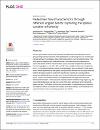Pedestrian flow characteristics through different angled bends: Exploring the spatial variation of velocity
| المؤلف | Hannun, Jamal |
| المؤلف | Dias, Charitha |
| المؤلف | Taha, Alaa Hasan |
| المؤلف | Almutairi, Abdulaziz |
| المؤلف | Alhajyaseen, Wael |
| المؤلف | Sarvi, Majid |
| المؤلف | Al-Bosta, Salim |
| تاريخ الإتاحة | 2022-10-19T06:57:43Z |
| تاريخ النشر | 2022-03 |
| اسم المنشور | PLoS ONE |
| المعرّف | http://dx.doi.org/10.1371/journal.pone.0264635 |
| الاقتباس | Hannun J, Dias C, Taha AH, Almutairi A, Alhajyaseen W, Sarvi M, et al. (2022) Pedestrian flow characteristics through different angled bends: Exploring the spatial variation of velocity. PLoS ONE 17(3): e0264635. https://doi.org/10.1371/ journal.pone.0264635 |
| الملخص | Common geometrical layouts could potentially be bottlenecks, particularly during emergency and high density situations. When pedestrians are interacting with such complex geometrical settings, the congestion effect might not be uniform over the bottleneck area. This study uses the trajectory data collected through a controlled laboratory experiment to explore the spatial variation of speeds when a group of people navigates through bends. Four turning angles, i.e., 45°, 90°, 135° and 180°, with a straight corridor and two speed levels, i.e., normal speed walking and slow running (jogging), were considered in these experiments. Results explained that the speeds are significantly different over the space within the bend for all angles (except 0°) under both speed levels. In particular, average walking speeds are significantly lower near the inner corner of the bend as compared to the outer corner. Further, such speed variations are magnified when the angle of the bend and desired speed increase. These outcomes indicate that even smaller turning angles, e.g., 45° could create bottlenecks near the inner corner of the bend, particularly when the walking speeds are high. The findings of this study could be useful in understanding the congestion and bottleneck effects associated with complex geometrical settings, and calibrating microscopic simulation tools to accurately reproduce such effects. |
| راعي المشروع | Open access funding was provided by the Qatar National Library. |
| اللغة | en |
| الناشر | Public Library of Science (PLOS) |
| الموضوع | pedestrian flow crowd movement crowd safety |
| النوع | Article |
| رقم العدد | 3 |
| رقم المجلد | 17 |
| ESSN | 1932-6203 |
الملفات في هذه التسجيلة
هذه التسجيلة تظهر في المجموعات التالية
-
السلامة المرورية [163 items ]


